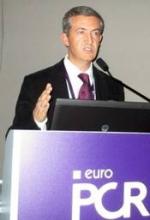PARIS – The monopoly Absorb has held in Europe since last September as the only bioresorbable vascular scaffold on the market is at an end.
In May, Elixir, a company that makes its own version of a different bioresorbable vascular scaffold (BVS), announced it received permission from the European Commission to market its DESolve BVS.
DESolve differs from Absorb by substantially disappearing within 6 months of placement with full resorption within a year, roughly twice the disappearing speed of Absorb, the first bioresorbable vascular scaffold on the European market.
This difference may have affected performance, said Dr. Alexandre Abizaid, who reported on a multicenter series of 126 patients who received DESolve BVS in a talk at the annual meeting of the European Association of Percutaneous Coronary Interventions.
"We got the same results after 6 months with this device as we see with Absorb after 2 or 3 years," said Dr. Abizaid, chief of coronary interventions at the Dante Pazzanese Cardiology Institute in São Paulo, Brazil."We saw the benefit from a BVS early on, with lumen enlargement and vessel enlargement.
"I would use this devise on the types of patients included in the study; younger patients with relatively short lesions, about 12 mm; patients who could benefit from vessel restoration; patients who might need coronary artery bypass surgery in the future; and patients with diabetes who seem to get the same results with this BVS as other patients. As we get more confident with the acute and long-term performance, we will expand the indications," Dr. Abizaid said.
Another feature of the DESolve BVS is that the 3.0-mm–diameter model can be balloon expanded to 4.8 mm before breaking, in contrast to the Absorb BVS, which can break when overexpansion surpasses 0.5 mm.
The results Dr. Abizaid reported on DESolve "led to the CE mark for the device. It will surely change our practice," commented Dr. Robert A. Byrne, an interventional cardiologist at the Heart Center in Munich. "When we have more bioresorbable scaffolds in the marketplace, we will see further development of this technology."
The DESolve Nx (notorolimus-eluting) pivotal trial included 126 patients at 13 centers in Brazil, New Zealand, and Europe. The study’s primary endpoint was the late lumen loss at 6 months, which averaged 0.21 mm, a rate that Dr. Byrne called "very good" compared with current standards.
Other measures reported by Dr. Abizaid further documented the extent of healing and vessel growth. "In the first 6 months, we usually see the lumen decrease due to scar tissue, but at 3-12 months we saw luminal enlargement that occurs as the scaffold degrades. There was a clear, statistically significant 17% increase in vessel area at 6 months, with a luminal increase of almost 10%, generally what we see after 3-4 years with Absorb," he said. In addition, imaging showed nearly 99% of all struts covered by tissue at 6 months. "The healing process is essentially complete" by then, he said.
Follow-up also showed low early recoil and no negative remodeling. In-segment binary restenosis occurred in one patient in whom the restenosis was within the scaffold, and in three patients where it occurred at the edge. During follow-up, clinically indicated revascularization was performed in two patients, a target vessel non–Q-wave myocardial infarction occurred in one patient, and cardiac death occurred in another.
"This device does its job to prevent negative remodeling in the first 4 months, and then it uncages the vessel, frees it to allow natural, positive remodeling. The potential advantages of the DESolve BVS are that degradation really happens within 1 year, and it gives you more freedom to postdilate if you need to. Having the device not fracture [during postdilation] is important," Dr. Abizaid said.
The DESolve Nx trial was sponsored by Elixir, which markets the stent. Dr. Abizaid said he has received research grants from Elixir, Abbott Vascular, Boston Scientific, and Medtronic. Dr. Byrne said his institution received research support from Biotronik.
On Twitter @mitchelzoler


